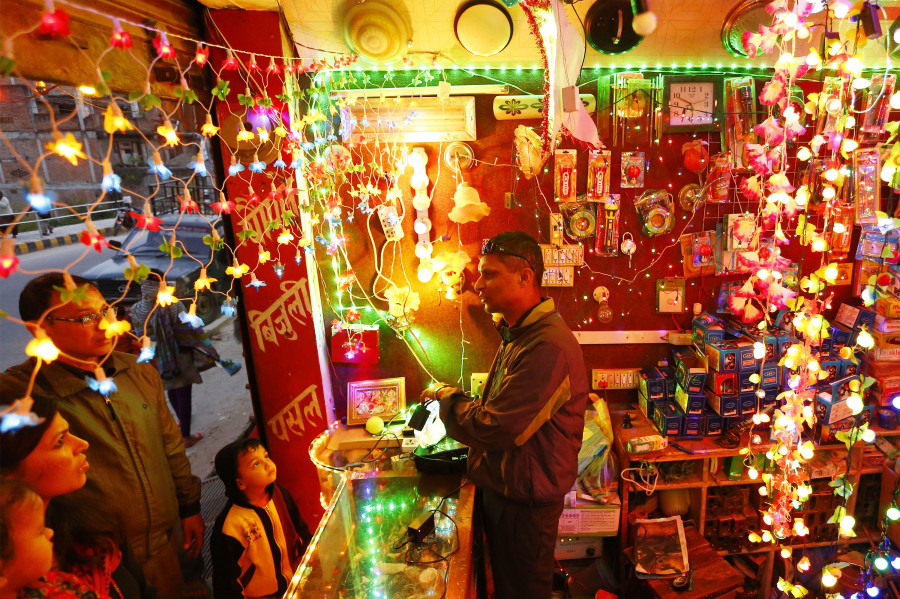Money
Low income puts a damper on Tihar mood
There is a festive crowd in the market, but the number of shopping bags has declined, traders say.
Krishana Prasain
Reports from the markets this week revealed that most people's pockets are dry on the eve of the Tihar festival.
The sweets, flowers, festival lights and dried fruits traders are not very enthusiastic about the festival of lights and flowers.
The five-day festival of lights begins Saturday.
A few traders to whom the Post spoke said it’s not that people have stopped buying but they are spending cautiously.
There is a festive crowd in the market but the number of shopping bags has declined.
During Tihar, sweets, dry fruits, footwear, watches, toys, home décor, and fashion clothing are the most sold items, which are gifted by sisters to their brothers as a token of love during the Bhai Tika, which falls on November 15.
“It looks like customers are on a tight budget. We are expecting the sales of festival lights worth Rs45 million this Tihar, down 20 percent compared to last year’s festival,” said Resham Prasad Devkota, president of the Federation of Electrical Entrepreneurs of Nepal.
“There are no orders for festival lights from the corporate and the construction sectors,” he said.
The slowdown in sales is because of the high inflation, traders say.
Nepalis like to spend lavishly during festivals, often saving up the entire year. But this year, it looks like their earnings have squeezed, dampening the festive sales, according to traders.
The year-on-year consumer inflation rose to 8.19 percent in October, with food and beverage inflation increasing to 9.74 percent, according to the Nepal Rastra Bank statistics.
People decorate their homes with strings of light bulbs hoping that Laxmi, the goddess of wealth, will visit them and bless them with prosperity. Christmas lights, rope lights and disco lights, among other products, make up most of the imports for the festival.
Devkota said that this year, the prices of electric lights are expected to increase by 20 percent due to new taxes imposed on the items.
According to festive light traders, over the past few years, people have been attracted more towards LED festive lights, which can operate for 2-3 years as they are comparatively more durable.
Devkota said that festival lights ordered for Tihar have started arriving in the market.
According to traders, 90 percent of festive lights come from China, followed by India.
Dried fruit traders are, too, not optimistic.
“There has been a decline in the purchasing capacity of the customers and it is expected to dampen the sales of dried fruits this Tihar,” said Amul Kaji Tuladhar, general secretary of the Nepal Retailers Association.
According to the association, 35 percent of annual sales of dried fruits take place during the five-day Tihar festival.
“The prices of dried fruits have not increased much compared to last Tihar,” said Tuladhar. “But sales are below our expectations.”
The prices of dates and cloves have increased, while the price of cashews, almonds, raisins, green cardamom, walnuts, and coconut has remained the same.
Most dried fruits sold in Kathmandu are imported from India, Pakistan, China, the US, Australia and other countries.
There is no problem in stock and supply of dried fruits, said traders.
According to the association, cashews cost Rs1,500 to Rs1,600 per kg and the price is as usual as last year. The price of almonds remains unchanged at Rs1,200 to Rs1,300 per kg.
Raisin is priced from Rs500 to Rs600 per kg and its price too has not changed.
However, the price of pistachios has increased sharply.
A kg of pistachio that cost Rs1,700 per kg during last year’s Tihar is priced at Rs2,200 per kg.
Dried dates that used to cost Rs200 per kg last year now cost Rs400 per kg.
Dried coconut that cost Rs550 per kg last year is priced at Rs475 per kg. Walnut that cost Rs550 per kg last Tihar is now available at Rs500.
Green cardamom price had reached Rs7,000 per kg last year, but this year its price has more than halved to Rs3,000 per kg.
The Singaporean betel nut is available at Rs1,300 per kg while Bombay betel nuts cost Rs1,900 per kg. Their prices have not changed much.
Last Tihar, cloves were priced at Rs1,300 per kg, but this time the price has soared to Rs1,900 per kg.
Similarly, marigold flowers, one of the Tihar essentials, are set to become pricier this year, according to florists.
“The retail price of a meter-long marigold garland is expected to reach Rs125 or more this year, compared to Rs100 last year,” said Min Bahadur Tamang, president of Floriculture Association Nepal. The imposition of VAT has made the imported marigold expensive this year.
Vibrant yellow marigolds and milky white chrysanthemums are necessary offerings to Laxmi during Tihar.
A standard meter-long garland contains 40 flowers.
The Floriculture Association Nepal expects a transaction of 3.5 million marigold garlands during the five-day-long Tihar festival.
“Out of 3.5 million marigold garlands, we might need to import 15 percent to 20 percent from India to meet the domestic demand,” said Tamang.
The increasing popularity of electric string lights has brought disappointment to makers of traditional earthen oil lamps. The sales of traditional oil lamps have dropped sharply, but traders say its charm, however, remains.
“The charm of the oil lamp never fades away as traditionally it is believed that goddess Laxmi comes only when the oil lamp is lighted,” said Roshan Prajapati, an oil lamp maker at Pottery Square in Bhaktapur.
Prajapati said he expects to make financial transactions between Rs50,000 to Rs100,000 during Tihar.
“No matter how many electric lights are used, people also buy at least half-a-dozen oil lamps, especially for Laxmi puja,” said Prajapati, who has been in the pottery business for the last 35 years.
The decorated oil lamp imported from India is hampering the traditional simple oil lamp of Nepal, Prajapati said.
The price of the oil lamp has not increased as it is available for Rs5 apiece. The pottery makers start making oil lamps 3-4 months before the Tihar begins.




 10.12°C Kathmandu
10.12°C Kathmandu













%20(1).jpg&w=300&height=200)
